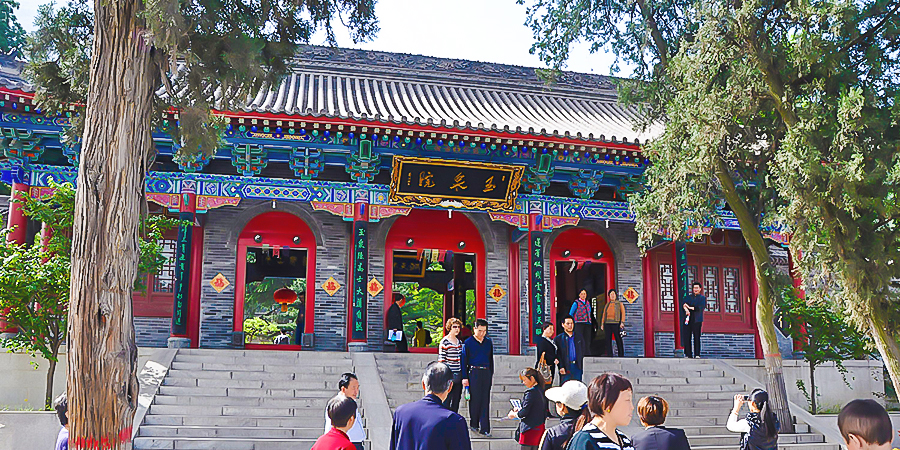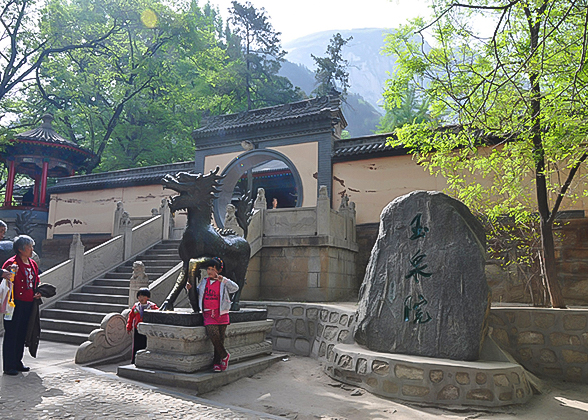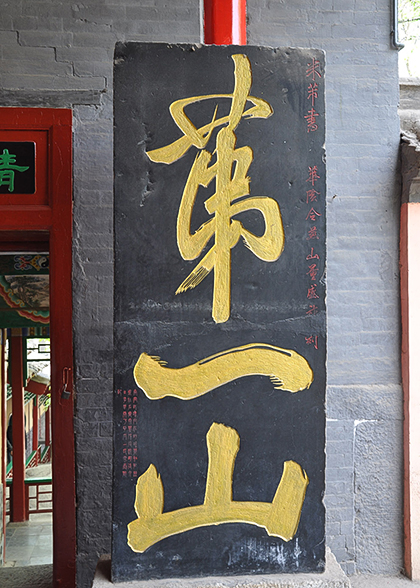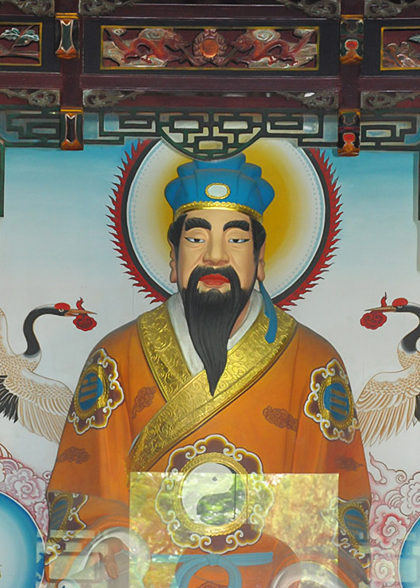Jade Spring Temple (Yuquan Temple)
 |
The present name of the temple originates from a charming legend that the Golden Fairy Princess washed her hair beside the Jade Well in Mount Huashan Guarding Palace unintentionally dropping her jade hair clasp into the well, but she eventually found the clasp in this temple as she washed her hands with the spring water. Since the spring was connected with the Jade Well, the princess gave it the name of Jade Spring.
 |
| Inside the Temple at the Foot of Mount Huashan |
The constructions here are mainly divided into east part, middle part and west part.
Tomb of Hua Tuo
In the east, there is the tombstone of Hua Tuo (145 - 208), a highly skilled doctor of the Eastern Han Dynasty (25 - 220). As is recorded, Hua Tuo used to visit his friend Mr. Lu who lived in Mount Huashan. They gathered herbs, made medicines and saved people’s lives together. After Hua Tuo was wrongly killed by Cao Cao (a militarist and the founder of Kingdom Wei of the Three Kingdom Period), his ghost went to Lu and told him of the injustice. Later Lu built a cenotaph in the Red Rock Village where the clothes of Hua Tuo were kept as he confirmed the death of Hua. Today, the original tomb has disappeared, but how and when the tombstone was moved to the temple is still a mystery.
Xiyi Hall
The middle part is the main body of Jade Spring Temple, whose main building is Xiyi Hall of quadrangle style. The hall is divided into front palace and back palace.
|
|
In the front palace stands the statue of Hao Datong who is the founder of the Mount Huashan School of Taoism. Many steles are erected outside the palace including poem steles eulogizing Mount Huashan, map steles of the overall mountain and a stele autographed with “the Number One Precipitous Mountain” by Mi Fu, a famous calligrapher of the North Song Dynasty. The inscription of Long Live Ancient Pine on the lintel of the door is autographed by Emperor Guangxu of the Qing Dynasty (1644 - 1911).
The back palace mainly functions to offer sacrifices to the sitting statue of Chen Tuan. There are two paintings on both sides of the lintel: One depicts Chen Tuan is playing chess while enjoying the sceneries of Mount Huashan with Zhao Kuangyin (the founding emperor of the Northern Song Dynasty). The other depicts Chen Tuan arriving at the mountain driving five dragons. In the east and west of the palace are sitting rooms and bed rooms decorated with simple construction materials. In the yard stands Jianjiao Stele written by Jia Desheng. This stele is of great value to research into the Taoist practice of Zhaijiao which aims to sacrifice to the gods and pray to keep away disasters and have good luck.
Other Small Scenic Spots
There are several attractive scenic spots in west of the temple including stone boat, Carefree Pavilion, Xiyi Cave, Shansun Pavilion, Heavenly Proceeding Pavilion and others.
Carefree Pavilion in the northwest is constructed facing the beautiful sceneries. It is so named because people feel more relaxed by viewing the scenes from the pavilion. As a balladry says that staying at the pavilion in the northwest of Jade Spring Temple gives people a sound sleep even though something important happens in their lives. In the temple, there is also an old tree near Shansun Pavilion built by Chen Tuan, which is called Carefree Tree.
Xiyi Cave is famous for the recumbent statue of Chen Tuan carved by Jia Desheng. It’s said that if someone hurts in some part of their body, he or she would shake off the pains as long as he or she touched the corresponding part of the statue.
Heavenward Proceeding Pavilion is so named because it stands facing the Heavenward Proceeding Gate of Golden Lock Pass. Leaving Jade Sping Temple from the pavilion, you can find the so-called “One Way to Mount Huashan”, which is 12.5 km (about 7.77 mi) in length with 9,567 steps.
| Opening Hours | Peak season (usually Mar. - Nov.): 08:00 - 19:00 Off Season (usually Dec. - Feb.): 08:00 - 17:00 |
| Admission Fee | Covered by the ticket of Mount Huashan, which is CNY 160 from March to November and CNY 100 from December to February. |

